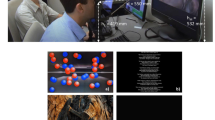Abstract
In this work we analyse the eye movements of people in transit in an everyday environment using a wearable electrooculographic (EOG) system. We compare three approaches for continuous recognition of reading activities: a string matching algorithm which exploits typical characteristics of reading signals, such as saccades and fixations; and two variants of Hidden Markov Models (HMMs) - mixed Gaussian and discrete. The recognition algorithms are evaluated in an experiment performed with eight subjects reading freely chosen text without pictures while sitting at a desk, standing, walking indoors and outdoors, and riding a tram. A total dataset of roughly 6 hours was collected with reading activity accounting for about half of the time. We were able to detect reading activities over all subjects with a top recognition rate of 80.2% (71.0% recall, 11.6% false positives) using string matching. We show that EOG is a potentially robust technique for reading recognition across a number of typical daily situations.
Preview
Unable to display preview. Download preview PDF.
Similar content being viewed by others
References
Bannach, D., Kunze, K., Lukowicz, P., Amft, O.: chapter Distributed Modular Toolbox for Multi-modal Context Recognition, pp. 99–113 (2006)
Barea, R., Boquete, L., Mazo, M., Lopez, E., Bergasa, L.M.: EOG guidance of a wheelchair using neural networks. In: Proceedings. 15th International Conference on Pattern Recognition, 2000, Barcelona, Spain, vol. 4, pp. 668–671 (2000)
Bulling, A., Herter, P., Wirz, M., Tröster, G.: Automatic artefact compensation in EOG signals. In: EuroSSC 2007: Adjunct Proceedings of the 2nd European Conference on Smart Sensing and Context, October 23–25 (2007)
Campbell, C.S., Maglio, P.P.: A robust algorithm for reading detection. In: PUI 2001: Proceedings of the 2001 workshop on Perceptive user interfaces, pp. 1–7. ACM Press, New York (2001)
Chouhan, V.S., Mehta, S.S.: Total removal of baseline drift from ECG signal. In: International Conference on Computing: Theory and Applications, ICCTA 2007, March 2007, pp. 512–515 (2007)
Gu, J.J., Meng, M., Cook, A., Faulkner, M.G.: A study of natural eye movement detection and ocular implant movement control using processed EOG signals. In: Proceedings 2001 ICRA. IEEE International Conference on Robotics and Automation, 2001, vol. 2, pp. 1555–1560 (2001)
Hayhoe, M., Ballard, D.: Eye movements in natural behavior. Trends in Cognitive Sciences 9, 188–194 (2005)
Keat, F.T., Ranganath, S., Venkatesh, Y.V.: Eye gaze based reading detection. In: TENCON 2003. Conference on Convergent Technologies for Asia-Pacific Region, October 15–17, vol. 2, pp. 825–828 (2003)
Logan, B., Healey, J., Philipose, M., Tapia, E., Intille, S.: chapter A Long-Term Evaluation of Sensing Modalities for Activity Recognition, pp. 483–500 (2007)
Maglio, P.P., Matlock, T., Campbell, C.S., Zhai, S., Smith, B.A.: Gaze and Speech in Attentive User Interfaces, p. 1 (2000)
Manabe, H., Fukumoto, M.: Full-time wearable headphone-type gaze detector. In: CHI 2006: CHI 2006 extended abstracts on Human factors in computing systems, pp. 1073–1078. ACM Press, New York (2006)
Murphy, K.P.: The HMM toolbox for MATLAB (1998), http://www.ai.mit.edu/~murphyk/software/hmm/hmm.html
Qiuping, D., Kaiyu, T., Guang, L.: Development of an EOG (electro-oculography) based human-computer interface. In: 27th Annual International Conference of the Engineering in Medicine and Biology Society IEEE-EMBS 2005, September 01–04, pp. 6829–6831 (2005)
Rabiner, L.R., Juang, B.H.: An introduction to hidden Markov models. IEEE ASSP Magazine, 4–16 (January 1986)
Sibert, J.L., Gokturk, M., Lavine, R.A.: The reading assistant: eye gaze triggered auditory prompting for reading remediation. In: UIST 2000: Proceedings of the 13th annual ACM symposium on User interface software and technology, pp. 101–107. ACM Press, New York (2000)
Tinati, M.A., Mozaffary, B.: A wavelet packets approach to electrocardiograph baseline drift cancellation. International Journal of Biomedical Imaging Article ID 97157, 9 pages (2006)
Van Laerhoven, K., Gellersen, H.-W., Malliaris, Y.G.: Long-term activity monitoring with a wearable sensor node. bsn 0, 171–174 (2006)
Vehkaoja, A.T., Verho, J.A., Puurtinen, M.M., Nojd, N.M., Lekkala, J.O., Hyttinen, J.A.: Wireless head cap for EOG and facial EMG measurements. In: 27th Annual International Conference of the Engineering in Medicine and Biology Society IEEE-EMBS 2005, September 01–04, pp. 5865–5868 (2005)
Venkataramanan, S., Prabhat, P., Choudhury, S.R., Nemade, H.B., Sahambi, J.S.: Biomedical instrumentation based on electrooculogram (EOG) signal processing and application to a hospital alarm system. In: Proceedings of 2005 International Conference on Intelligent Sensing and Information Processing, January 4–7, pp. 535–540 (2005)
Ward, J.A., Lukowicz, P., Tröster, G.: Evaluating performance in continuous context recognition using event-driven error characterisation. Location- and Context-Awareness, 239–255 (2006)
Ward, J.A., Lukowicz, P., Tröster, G., Starner, T.E.: Activity recognition of assembly tasks using body-worn microphones and accelerometers. IEEE Transactions on Pattern Analysis and Machine Intelligence 28(10), 1553–1567 (2006)
Wijesoma, W.S., Kang, S.W., Ong, C.W., Balasuriya, A.P., Koh, T.S., Kow, K.S.: EOG based control of mobile assistive platforms for the severely disabled. In: IEEE International Conference on Robotics and Biomimetics (ROBIO), pp. 490–494 (2005)
Yingxi, C., Newman, W.S.: A human-robot interface based on electrooculography. In: 2004 IEEE International Conference on Robotics and Automation Proceedings ICRA 2004, April 26–May 1, vol. 1, pp. 243–248 (2004)
Author information
Authors and Affiliations
Editor information
Rights and permissions
Copyright information
© 2008 Springer-Verlag Berlin Heidelberg
About this paper
Cite this paper
Bulling, A., Ward, J.A., Gellersen, H., Tröster, G. (2008). Robust Recognition of Reading Activity in Transit Using Wearable Electrooculography. In: Indulska, J., Patterson, D.J., Rodden, T., Ott, M. (eds) Pervasive Computing. Pervasive 2008. Lecture Notes in Computer Science, vol 5013. Springer, Berlin, Heidelberg. https://doi.org/10.1007/978-3-540-79576-6_2
Download citation
DOI: https://doi.org/10.1007/978-3-540-79576-6_2
Publisher Name: Springer, Berlin, Heidelberg
Print ISBN: 978-3-540-79575-9
Online ISBN: 978-3-540-79576-6
eBook Packages: Computer ScienceComputer Science (R0)



